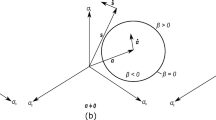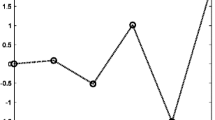Abstract
We present a contribution to a relatively unexplored application of topology optimization: structural topology optimization with fatigue constraints. A probability based high-cycle fatigue analysis is combined with principal stress calculations in order to find the topology with minimum mass that can withstand prescribed variable-amplitude loading conditions for a specific life time. This allows us to generate optimal conceptual designs of structural components where fatigue life is the dimensioning factor. We describe the fatigue analysis and present ideas that make it possible to separate the fatigue analysis from the topology optimization. The number of constraints is kept low as they are applied to stress clusters, which are created such that they give adequate representations of the local stresses. Optimized designs constrained by fatigue and static stresses are shown and a comparison is also made between stress constraints based on the von Mises criterion and the highest tensile principal stresses. The paper is written with focus on structural parts in the avionic industry, but the method applies to any load carrying structure, made of linear elastic isotropic material, subjected to repeated loading conditions.








Similar content being viewed by others
References
Allaire G, Jouve F (2008) Minimum stress optimal design with the level set method. Eng Anal Bound Elem 32(11):909–918
Bendsøe M (1989) Optimal shape design as a material distribution problem. Struct Optim 1(4):193–202
Bruggi M (2008) On an alternative approach to stress constraints relaxation in topology optimization. Struct Multidiscip Optim 36(2):125–141
Bruns T, Tortorelli D (2001) Topology optimization of non-linear elastic structures and compliant mechanisms. Comput Methods Appl Mech Eng 190(26–27):3443–3459
Cheng G, Guo X (1997) ε-relaxed approach in structural topology optimization. Struct Multidiscip Optim 13(4):258–266
Christensen P, Klarbring A (2008) An introduction to structural optimization, vol 153. Springer Verlag
Dahlberg T, Ekberg A (2002) Failure, fracture, fatigue: an introduction. Studentlitteratur
Desmorat B, Desmorat R (2008) Topology optimization in damage governed low cycle fatigue. Comptes Rendus Mecanique 336(5):448–453
Duysinx P, Bendsøe M (1998) Topology optimization of continuum structures with local stress constraints. Int J Numer Methods Eng 43(8):1453–1478
Duysinx P, Sigmund O (1998) New developments in handling stress constraints in optimal material distribution. In: 7th AIAA/USAF/NASA/ISSMO symposium on multidisciplinary design optimization, AIAA Paper 98-4906, pp 1501–1509
Gruen F, Eichlseder W, Puchner K (2003) Shape- and topology optimization regarding fatigue analysis. Cumulative Fatigue Damage, Seville (Spain)
Guo X, Cheng G, Yamazaki K (2001) A new approach for the solution of singular optima in truss topology optimization with stress and local buckling constraints. Struct Multidiscip Optim 22(5):364–373
Haftka R, Gürdal Z, Kamat M (1990) Elements of structural optimization. Kluwer Academic Publishers
Holmberg E, Torstenfelt B, Klarbring A (2013a) Stress constrained topology optimization. Structural and Multidisciplinary Optimization, 1–15. doi:10.1007/s00158-012-0880-7
Holmberg E, Torstenfelt B, Klarbring A (2013b) Global and clustered approaches for stress constrained topology optimization and deactivation of design variables. In: 10th World congress on structural and multidisciplinary optimization
Kaya N, Karen İ, Öztürk F (2010) Re-design of a failed clutch fork using topology and shape optimisation by the response surface method. Mater Des 31(6):3008–3014
Kirsch U (1990) On singular topologies in optimum structural design. Struct Multidiscip Optim 2(3):133–142
Le C, Norato J, Bruns T, Ha C, Tortorelli D (2010) Stress-based topology optimization for continua. Struct Multidiscip Optim 41(4):605–620
Mrzyglod M, Zielinski A (2006) Numerical implementation of multiaxial high-cycle fatigue criterion to structural optimization. J Theor Appl Mech 44(3):691–712
Mrzyglod M, Zielinski A (2007a) Multiaxial high-cycle fatigue constraints in structural optimization. Int J Fatigue 29(9):1920–1926
Mrzyglod M, Zielinski A (2007b) Parametric structural optimization with respect to the multiaxial high-cycle fatigue criterion. Struct Multidiscip Optim 33(2):161–171
MSC Software: MSC Fatigue (2013). http://www.mscsoftware.com
Optistruct (2012) 11.0, users manual. Altair engineering. Inc., Troy, MI
París J, Navarrina F, Colominas I, Casteleiro M (2009) Topology optimization of continuum structures with local and global stress constraints. Struct Multidiscip Optim 39(4):419–437
París J, Navarrina F, Colominas I, Casteleiro M (2010) Block aggregation of stress constraints in topology optimization of structures. Adv Eng Softw 41(3):433–441
Pedersen N (2000) Maximization of eigenvalues using topology optimization. Struct Multidiscip Optim 20(1):2–11
Pedersen N, Nielsen A (2003) Optimization of practical trusses with constraints on eigenfrequencies, displacements, stresses, and buckling. Struct Multidiscip Optim 25(5):436–445
Rozvany G, Birker T (1994) On singular topologies in exact layout optimization. Struct Multidiscip Optim 8(4):228–235
Seyranian A, Lund E, Olhoff N (1994) Multiple eigenvalues in structural optimization problems. Struct Multidiscip Optim 8(4):207–227
Suresh S (1998) Fatigue of materials. Cambridge University Press
Svanberg K (1987) The method of moving asymptotes - a new method for structural optimization. Int Journal Numer Methods Eng 24(2):359–373
Svanberg K (2002) A class of globally convergent optimization methods based on conservative convex separable approximations. SIAM J Optim 12(2):555–573
Torstenfelt B (2013) The TRINITAS project. http://www.solid.iei.liu.se/Offered_services/Trinitas
Wang MY, Luo Y (2013) An enhanced aggregation method for stress-constrained topology optimization problems. In: 10th World congress on structural and multidisciplinary optimization
Zhang WS, Guo X, Wang MY, Wei P (2013) Optimal topology design of continuum structures with stress concentration alleviation via level set method. Int J Numer Methods Eng 93(9):942–959
Author information
Authors and Affiliations
Corresponding author
Appendix
Appendix
Differentiating (13) with respect to design variable x b gives
Using \(\frac {\partial I_{ij}}{\partial x_{b}}=0\) and rearranging gives
The eigenvector \(\phi _{j}^{\alpha }\) is a unit vector, i.e.,
therefore, if we premultiply (25) by \(\phi _{i}^{\alpha }\), we get
and rearranging the right hand side of (26) gives
As both S i j and I i j are symmetric, we can rewrite as
where the zero comes from (13). Combining (26), (27) and (28), we now find that the derivative of the eigenvalues with respect to the design variable reads
Rights and permissions
About this article
Cite this article
Holmberg, E., Torstenfelt, B. & Klarbring, A. Fatigue constrained topology optimization. Struct Multidisc Optim 50, 207–219 (2014). https://doi.org/10.1007/s00158-014-1054-6
Received:
Revised:
Accepted:
Published:
Issue Date:
DOI: https://doi.org/10.1007/s00158-014-1054-6




